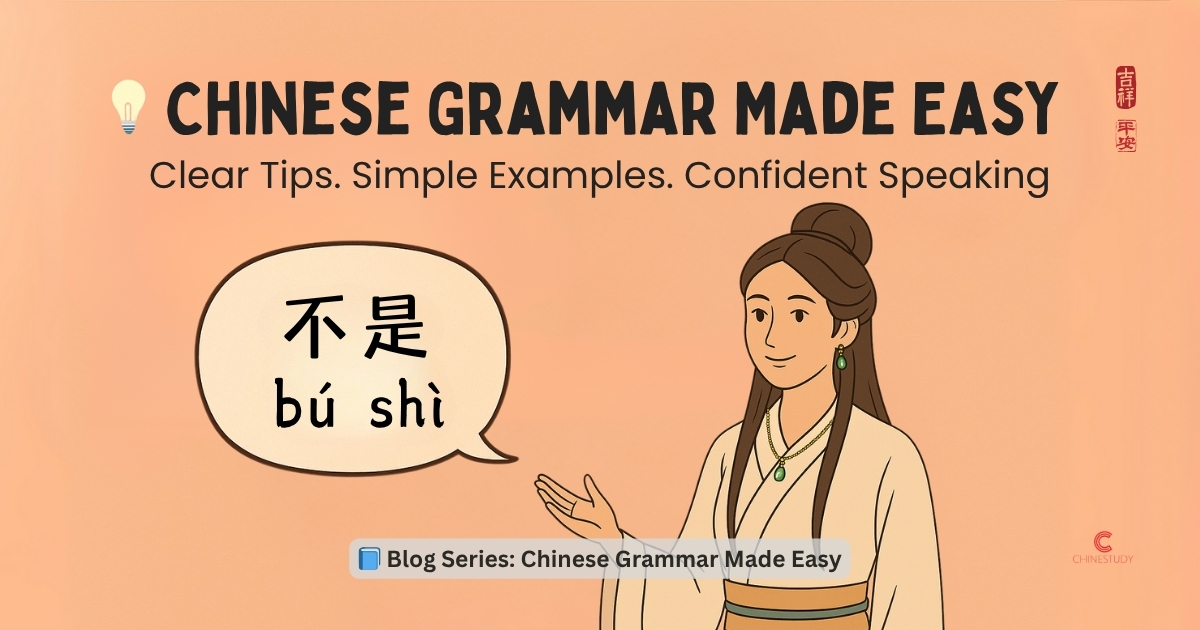|
Subject |
不是 (bú shì) |
Noun |
|---|---|---|
|
我 |
不是 |
老师 |
|
wǒ |
bú shì |
lǎoshī |
|
I |
am not |
teacher |
How to Say “Not” in Chinese: Using 不是 (bú shì)

If you want to say “am not,” “is not,” or “are not” in Chinese, it’s very simple.
You just need two words: 不是 (bú shì).
Let’s see how it works.
📚 What Is 不是 (bú shì)?
不是 (bú shì) = “am not,” “is not,” or “are not”
It’s simply the negation of 是 (shì).
Chinese makes this easy:
Just put 不 (bù, not) before 是 (shì).
Because of tone change rules, 不 (bù) changes to bú before the 4th tone shì.
Structure:
👤 Subject + 不是 (bú shì) + Noun / Pronoun
💡 Examples
1.
我不是老师。
(Wǒ bú shì lǎoshī.)
→ I am not a teacher.
👉 Let’s break it down:
2.
他不是学生。
(Tā bú shì xuéshēng.)
→ He is not a student.
👉 Let’s break it down:
|
Subject |
不是 (bú shì) |
Noun |
|---|---|---|
|
他 |
不是 |
学生 |
|
tā |
bú shì |
xuéshēng |
|
he |
is not |
student |
3.
你不是医生。
(Nǐ bú shì yīshēng.)
→ You are not a doctor.
👉 Let’s break it down:
|
Subject |
不是 (bú shì) |
Noun |
|---|---|---|
|
你 |
不是 |
医生 |
|
nǐ |
bú shì |
yīshēng |
|
you |
are not |
doctor |
4.
我们不是同学。
(Wǒmen bú shì tóngxué.)
→ We are not classmates.
👉 Let’s break it down:
|
Subject |
不是 (bú shì) |
Noun |
|---|---|---|
|
我们 |
不是 |
同学 |
|
wǒmen |
bú shì |
tóngxué |
|
we |
are not |
classmates |
🎯 Practice Time!
👉 Change the affirmative sentences into negative sentences.
1️⃣ 我是老师。
(Wǒ shì lǎoshī.)
I am a teacher.
2️⃣ 她是医生。
(Tā shì yīshēng.)
She is a doctor.
3️⃣ 他是学生。
(Tā shì xuéshēng.)
He is a student.
✅ Answers:
1️⃣ 我不是老师。
(Wǒ bú shì lǎoshī.)
I am not a teacher.
2️⃣ 她不是医生。
(Tā bú shì yīshēng.)
She is not a doctor.
3️⃣ 他不是学生。
(Tā bú shì xuéshēng.)
He is not a student.
❗ Common Mistakes: Be Careful with Word Order
Some learners try to put 不 (bù) after 是 (shì) because they are thinking in English:
“I am not a teacher.”
But in Chinese, the word 不 comes before 是.
✅ Correct:
我不是老师。
(Wǒ bú shì lǎoshī.)
I am not a teacher.
❌ Wrong:
我是不老师。
This is not correct in Chinese grammar.
💡 Why?
不 (bù) is used to negate the verb.
In this case, the verb is 是 (shì).
So the correct order is always:
不 + 是 → 不是
💡 Easy Tip to Remember
Think of 不是 (bú shì) as a simple “no” to 是 (shì).
Instead of changing verbs, just add 不 (bù) in front. Easy!
🚀 Your Turn! Practice in Real Life
Grammar is useful only if you use it in real life!
Here’s a small challenge for you today:
👉 Think of 3 things about yourself that you are NOT.
Write them down in Chinese using 不是 (bú shì).
For example:
- 我不是医生。 (Wǒ bú shì yīshēng.)
→ I am not a doctor.
- 我不是美国人。 (Wǒ bú shì Měiguó rén.)
→ I am not American.
- 我不是老师。 (Wǒ bú shì lǎoshī.)
→ I am not a teacher.
Say them out loud or write them in your notebook.
The more you practice, the more natural it will feel.
💬 You can even try writing your sentences here or share them with a language partner!
🌟 Want step-by-step guidance?
👉 Check out my course: Mandarin Chinese Grammar Masterclass for Beginners.
👉 Explore the full blog series: Chinese Grammar Made Easy.
Thank you for subscribing!
Have a great day!